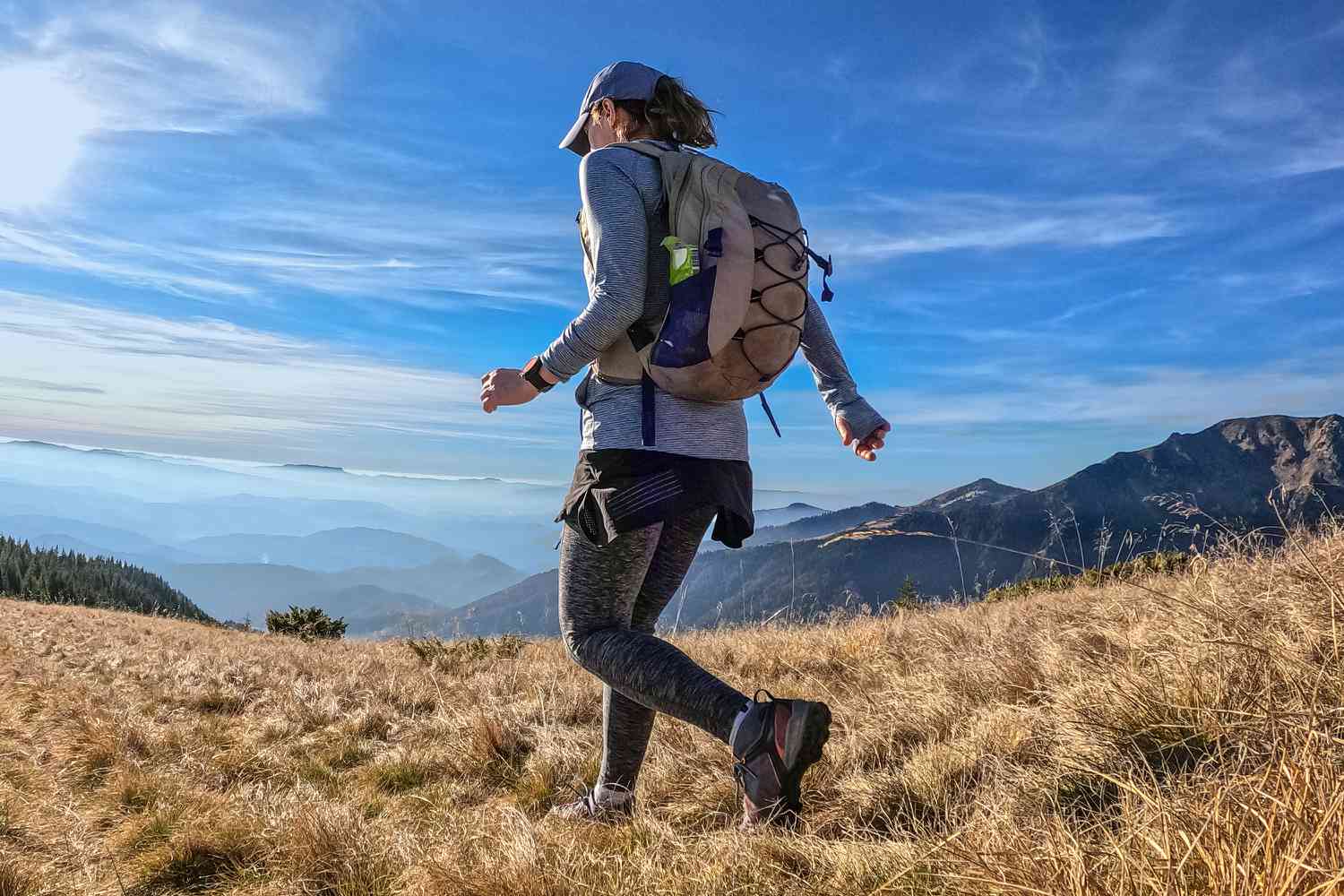Cosa è il Rucking? Ecco cosa devi sapere per iniziare.

Le tendenze del fitness vanno e vengono, ma una delle ultime ossessioni di allenamento su TikTok (e nella vita reale) è un'attività che esiste da sempre: il rucking. Che cos'è il rucking, esattamente? Semplicemente, è un nome sofisticato per camminare mentre si porta un peso extra sulla schiena.
Per quanto semplice possa sembrare, il rucking sta diventando popolare perché è un esercizio facilmente accessibile ed efficace. "È una forma di esercizio con una barriera d'ingresso molto bassa che porta molti benefici", afferma Tasia Percevez, ambasciatrice dell'azienda di attrezzatura per il rucking GORUCK, che ha praticato il rucking come parte delle competizioni di CrossFit. "Tutto ciò di cui hai bisogno è uno zaino." Mettici dentro alcuni libri o bottiglie d'acqua, prendi la strada e sei pronto.
Se sembra un allenamento a cui potresti dedicarti, continua a leggere per una guida completa su cos'è il rucking, cosa può fare per il tuo fitness e come integrarlo al meglio nella tua routine.
Anche se il termine "rucking" ti è nuovo, probabilmente conosci già l'attività stessa. Dal momento che il rucking è semplicemente camminare con uno zaino pesante, Tony Vacharasanee, appassionato di rucking e personal trainer certificato NASM, fa notare che "è probabile che tutti noi abbiamo fatto una qualche forma di rucking quando eravamo a scuola". Il rucking non deve necessariamente essere fatto con uno zaino: qualsiasi cosa che aggiunga peso va bene. Alcune persone utilizzano un gilet pesato, mentre altre camminano portando il bambino in fascia o sulle spalle - e sì, anche questo conta!
Il rucking può anche essere parte di un'escursione. Chiunque abbia mai fatto escursionismo sui sentieri - o abbia portato acqua extra e un pranzo sulla vetta - ha praticato il rucking, anche se non l'ha chiamato così. "L'escursionismo e il rucking sono praticamente fratelli", afferma Vacharasanee. "L'escursionismo è il rucking nella natura e l'escursionismo urbano è il rucking".
Anche se molte persone considerano l'allenamento militare come l'origine del rucking, la terapista fisica Jessica Olivarez, D.P.T., che ha cominciato a praticare il rucking nell'esercito e ora guida un gruppo di rucking per adulti, fa notare che non è stato il primo luogo in cui le persone camminavano trasportando cose. In realtà, si tratta di una routine di fitness che è praticamente antica come l'umanità stessa.
A cosa serve il rucking? A un sacco di cose utili. È un modo a basso impatto per aumentare la frequenza cardiaca per un allenamento cardiovascolare. La resistenza aggiunta aiuta a rafforzare le ossa e gruppi muscolari come polpacci, muscoli posteriori della coscia, quadricipiti, core, schiena, spalle e persino i piedi. Inoltre, mette alla prova il tuo equilibrio. E a meno che non lo faccia sul tapis roulant, ti fa uscire all'aperto, cosa che è dimostrato essere benefico per la salute mentale.
Anche se il rucking non aumenta la frequenza cardiaca tanto quanto la corsa, supera la semplice passeggiata: ti offre una sfida cardiovascolare maggiore e può bruciare fino a tre volte più calorie, a seconda del peso che porti, afferma Vacharasanee. Tuttavia, rimane a basso impatto, il che significa che è più facile sulle articolazioni, quindi puoi farlo quotidianamente con poco rischio di infortuni. "Ti prepara anche per la vita di tutti i giorni", afferma Olivarez. Che tu debba portare la spesa in macchina o il bambino giù per le scale, il rucking ti darà la forza per farlo. "In pratica, rende la vita meno difficile da vivere", aggiunge. "Dico ai miei pazienti che mette soldi nella loro banca della forza in modo che quando svolgono attività che richiedono loro di trasportare o spostare cose, non si trovino a corto di denaro".
Puoi fare rucking con qualsiasi zaino con spallacci larghi. Tuttavia, gli zaini specifici per il rucking presentano caratteristiche come uno scomparto speciale per le piastre di peso, un'imbottitura extra sulla zona lombare, eventualmente una cinghia per la vita o per il petto e maniglie extra in modo da poter usare lo zaino per esercizi di potenziamento muscolare. La maggior parte offre uno spazio per riporre l'acqua, tramite una tasca laterale per una bottiglia o uno spazio per una sacca d'acqua.
Alcune persone fanno rucking indossando gilet pesati, che possono aiutare a distribuire il carico in modo più uniforme sul torace. Ma Vacharasanee afferma che questi possono a volte limitare la respirazione. Inoltre, non sono altrettanto versatili. "A meno che non stiate indossando un giubbotto antiproiettile per lavoro, l'unica cosa per cui potete usarlo è l'esercizio", dice Vacharasanee. "Mentre uno zaino da rucking è molto meno appariscente. Sicuramente attiro molta meno attenzione rispetto a quando usavo il gilet pesato per uscire a fare rucking".
Ispirato a provare il rucking? Ecco come farlo nel modo giusto.
Indipendentemente dal tuo livello di forma fisica, tieni lo zaino leggero all'inizio - non più del tre al cinque percento del tuo peso corporeo, dice Olivarez. "Con ogni nuova attività, il modo migliore per iniziare è iniziare lentamente e progredire in base a come ti senti", afferma.
One of the perks of rucking is that it actually inspires good posture. “It's extremely uncomfortable to have bad posture while rucking,” says Vacharasanee. Just focus on keeping the weight over your center of gravity, or midfoot, which means you’ll want a slight forward lean in your trunk without slouching.
Also, keep an eye on your stride. “You're pulling your leg forward with the hip muscle and then driving forward with the back leg. It's a deliberate stepping versus just kind of a lackadaisical walking,” says Olivarez.
Olivarez suggests trying to place the weight as high up in your backpack as possible. “Roll up some towels in the bottom or [use] a yoga block to get that weight to the top of the bag,” she says. This will make it easier to maintain good form while you walk.
If you’re not already a regular walker, Olivarez suggests starting with a weight equal to three percent of your body weight and heading out for 15 to 20 minutes or a mile a couple of times a week. Or, if you regularly walk three to five miles, you can start by adding five percent of your body weight for half the distance you’d normally walk, and see how your body responds. Regardless of your athletic background, don’t try to carry more than 10 pounds until you get used to the activity, warns Vacharasanee
“If you're really sore, then drop the weight down, go a little shorter on time, slow down a little, take seated rest breaks,” Olivarez suggests. “Skip a day or two to let your body return to its baseline, and then continue to progress again.”
As you get more comfortable, experiment with the variables: Add more weight (no more than five pounds per week, says Vacharasanee), more time, or pick up the pace. “If you have access to hills, you can walk up a hill at a fast pace and recover on the walk down,” says Percevez.
Intervals are another great way to spice up your workout. Percevez likes to challenge herself with intervals that alternate two minutes at a fast pace with one minute of recovery. Or, after every 10 minutes of walking, she’ll do 10 squats or lunges with the pack on.
Depending on your goals, Olivarez might recommend doing two shorter rucks each week of 45 to 60 minutes while carrying 15 to 20 percent of your body weight, then one longer ruck on the weekend of two to three hours with a lighter weight to build up your endurance. “Someone who's doing it for military training or ruck-centric fitness challenges like a big 24- to 48-hour rucking tour of a city, you have to train three to four times a week [and] add in weightlifting and some functional fitness,” she says.
Advanced ruckers that want to add some variation to their routine can also try rucking backward up a hill. Olivarez sometimes has her groups do this to work their hamstrings and quads in a new way. “Then I might have them wear their pack on the front for a little bit just to get the backside of the body a different challenge,” says Olivarez. “It's a very versatile piece of equipment — you're only limited in your imagination of what you can try.”
Before heading out, you’ll want to make sure you have water with you (fortunately, backpacks offer a convenient place to carry it!) and that you’ve fueled yourself with enough calories.
Be sure to wear closed-toe shoes to keep your feet secure — any comfortable sneaker or hiking boot will do, says Vacharasanee. If you’re out after dark, wear bright colors or lights. And if you have to walk on the shoulder of a road, go against the direction of traffic so you can see cars coming. “Just be super aware of your surroundings,” says Percevez.
No matter your age or fitness level, as long as you can safely walk, you can ruck. If you do it at least once or twice a week, Vacharasanee says, you’ll start to see stronger muscles throughout your body, plus greater cardio endurance.
And it doesn’t even have to take extra time out of your day. “You can literally put on weight while walking the dog, shopping for groceries, doing any activity while you would be on your feet anyway, and you'll get more benefit out of it with a fraction of the impact on your joints that you would get from running,” says Vacharasanee.
You can also turn it into a social activity. People of different fitness levels can easily ruck together by carrying different amounts of weight, points out Percevez, who admits that the community element is one thing she especially loves about rucking: “You can exercise in a way that you can talk to your friends at the same time.”




